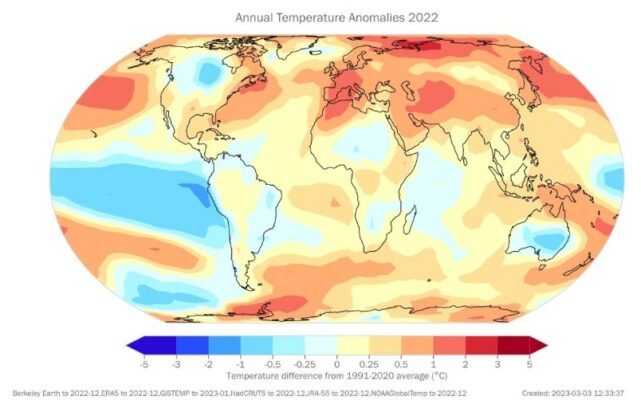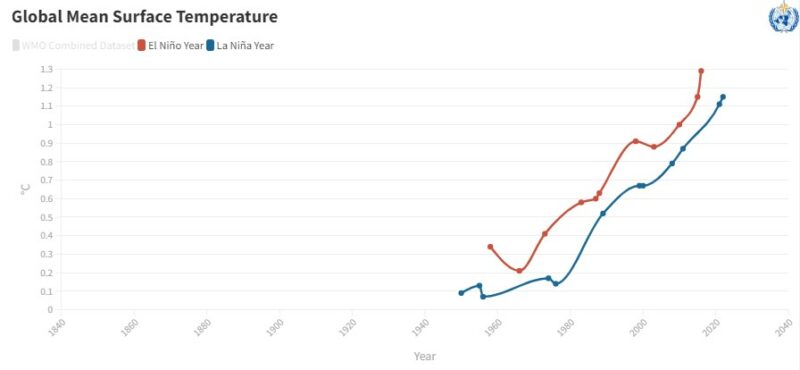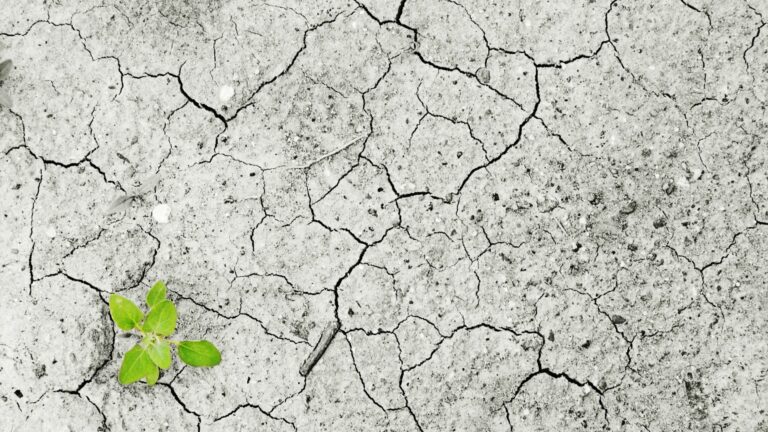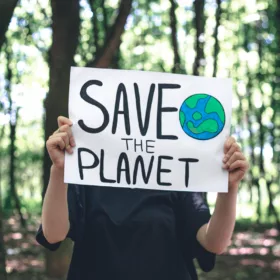Earth Day 2023 was celebrated on Saturday 22 April. Numerous initiatives were held in the most important cities of the world to celebrate the Earth and spread knowledge about the ongoing climate change and the impact that our society has on our planet. But what was the state of the global climate in 2022?
The answer to this question was provided by the World Meteorological Organization (WMO), which just one day before Earth Day published its annual report on global climate, the State of the Global Climate 2022. The answer, however, as unfortunately predicted, is not exactly positive.
WMO uses seven different indicators to monitor and describe climate change: the composition of the atmosphere, the behavior of land, oceans and glaciers, extreme weather events, risks and possible actions to be taken.
Here are the main results.
Climate change in the atmosphere
The 2022 report finds a substantial balance in the atmospheric concentrations of greenhouse gases between emissions deriving from human and non-human activities. As known, the increase in greenhouse gas emissions deriving from human activities represents one of the main causes of climate change and also for 2022 the data indicate that these have continued to grow.
The main greenhouse gases present in the atmosphere are carbon dioxide, methane and nitrous oxide, which in 2021 (the last year for which complete data is currently available) recorded record values.
- The atmospheric concentration of carbon dioxide (measured in parts per million – ppm) has reached a value of 415.7 ppm ± 0.2, or 149% of pre-industrial values.
- The concentration of methane (measured in parts per billion – ppb), a greenhouse gas 25 times more potent than carbon dioxide in trapping heat in the atmosphere, reached the value of 1908±2 ppb, equivalent to 262% of the values pre-industrial. An increase of 18 ppb over the previous year, the largest on record.
- The concentration of nitrous oxide (ppb) recorded a value of 334.5±0.1 ppb, equal to 124% of pre-industrial levels.
Methane emissions come from both human and natural sources. In particular, wetlands are among the main natural sources and will need to be monitored, especially the tropical ones, to better understand the changes in greenhouse gases and be able to adopt more effective strategies to mitigate the impact on the global climate.
The effects of climate change on land
Increasing emissions and concentrations of greenhouse gases in the atmosphere inevitably lead to an increase in the global mean surface temperature (GMST), which is measured using a difference from a reference period of the combination of land air temperature and temperature of the ocean surface.
The planet’s temperature in 2022 was 1.15 ± 0.13°C warmer than the pre-industrial average (1850-1900). This means that the last 8 years have been the warmest on record.

A fundamental element to determine the annual temperature variations is given by the phenomenon called El Niño/La Niña Southern Oscillation (ENSO). This consists in the presence of temperature fluctuations of the surface in the central part of the Pacific Ocean. In particular, El Niño results in warmer ocean temperatures, while La Niña results in “colder” ocean temperatures.
While 2022 was characterized primarily by La Niña conditions, it was still the fifth warmest year on record. As shown in the graph below, even in the presence of years characterized mainly by La Niña, the trend is inevitably directed towards an increase in temperatures.

How climate change is affecting the conditions of seas and oceans
Approximately 90% of the excess energy Earth accumulates from greenhouse gases ends up in the oceans, which continued their warming trend into 2022. What does this directly entail?
- Coral bleaching: very sensitive to temperature changes, corals protect coasts from storms and erosion and create entire ecosystems, also serving as a source of nutrition.
- Sea level rise: As water warms, it expands, contributing to sea level rise along with the melting of ice caps and glaciers. Global sea level rose again in 2022, following the trend recorded with satellite altimeters over the last thirty years, which sees an average rise of 3.4 ± 0.3 mm per year.
- Ocean acidification: it is a direct consequence of the increase in the concentration of CO2 produced by man, of which 25% is absorbed by the oceans, providing partial relief for climate change. This comes at a price though. In fact, the increase in acidity endangers ecosystems, food security linked to fishing and coastal protection linked to the presence of coral reefs. The more the pH of the sea decreases, and therefore the acidity increases, the more the CO2 absorption capacity decreases. The pH of the seas is constantly decreasing, with rates of decrease never seen in the last 26,000 years.
The state of the cryosphere
For most of 2022, Arctic sea ice extent was below the long-term average. In particular, in September the satellite surveys showed an extension of 0.71 million km2 lower than the average. As for Antarctica, on 25 February 2022 the lowest extension ever was recorded with 1.92 million km2, almost 1 million km2 below the average, a trend that remained constant throughout the year .
For the Greenland ice sheet, the total mass balance was also negative. It’s the 26th year in a row.
The situation for the glaciers has not been better.
Since the World Glacier Monitoring Service started the observation of the evolution of glaciers’ mass balance around the world in 1950, this value has been declining almost every year. The only exceptions occurred in 1955, 1964, 1965, 1983 and 1987. This means that in the last 35 years the balance has been constantly negative and in 2022 record values were reached. In particular, between 2021 and 2022 the Swiss Alps lost 6% of the total ice volume. For the first time in history, no amount of snow survived the summer, not even at the highest Alpine survey points.
Extreme weather events
The most evident manifestation of climate change is given by the extreme weather events that are increasingly occurring all over the world. 2022 was no exception.
China experienced the most widespread and long-lasting heat wave in its history, from mid-June to the end of August, making it the hottest summer on record, with a margin of more than 0.5°C. Nearly all of Southern China saw seasonal rainfall well below average, and 366 locations recorded their own record temperatures.
Japan achieved a record 9 consecutive days above 35°C in Tokyo, from June 25 to July 3.
Waves of intense heat have also plagued Europe, with numerous records recorded in various cities and countries, including the June temperature record in Rome (40.0°C on 27 June) and the first time in history that the United Kingdom has recorded a temperature over 40 degrees (July 19 in Coningsby, 40.3 °C). Over 4,600 deaths in Spain, 4,500 in Germany, 2,800 in the UK, 2,800 in France and 1,000 in Portugal have been associated with excessive heat.
Record maximum temperatures were registered in Finland, Estonia, Tunisia, Morocco, Uruguay, Argentina. Prolonged heat waves have inevitably brought considerable drought to the North American west coast, France, Germany, Morocco, Northern Italy, the Iberian peninsula, Iran, Iraq, Kenya, Somalia, Ethiopia.
Conditions that have favored devastating wildfires in France, Algeria, northern Argentina, Paraguay and the Brazilian Amazon forest.
In addition to the extreme heat, there have been exceptional floods, especially in Pakistan, Nigeria, Chad, Sudan, Australia and record snowstorms in the USA.
Here is an interactive map of the WMO showing in more detail all the extreme events that occurred in 2022.
Risks and consequences
All of the above has the first impact of putting the achievement of sustainable development goals at risk.
In 2021, 2.3 billion people faced food insecurity and 10% of the world’s population was undernourished.
The exceptional pre-monsoon heat in India and Pakistan has led to a decline in harvests which, combined with export bans, has threatened and continues to threaten international food markets, with the risk to deprive already deficient countries of further staple foods. The monsoon floods that hit Pakistan later helped spread diseases through the water and led to the deaths of 1,700 people and 936,000 livestock animals. The severe drought faced, has led the Great Horn of Africa to face unsustainable food crises and Afghanistan and Syria have followed the same trajectory.
A consequence of these events has been the displacement of populations. The floods in Pakistan affected 33 million people, causing 8 million displaced people, of whom about 600,000 live in relief sites. 7.2 million have been affected by the floods in Bangladesh, while the Indian state of Assam has seen 663,000 displaced. Tropical cyclones have displaced over 190,000 people in Malawi and 20,000 families in Mozambique.
The effects of climate change are already affecting entire ecosystems and will increasingly do so. An example is given by the flowering of cherry blossoms in Japan, documented since 801 AD, which was progressively anticipated by the changes, up to the record date of 2021, i.e. March 26th.
Even the mountain ecosystems are strongly affected, seeing their water basins reduced and consequently the cultivation capacity. This puts 1.9 million people living in mountain areas at risk.
The loss of biodiversity is inevitable, just consider that the number of species destined to become extinct increases drastically with the increase in global temperatures. The risk is 30% higher with a 2°C warming than with a 1.5°C warming.
Finally, climate change threatens Arctic, marine and coastal ecosystems.
What can we do?
The first and most immediate operation is to continue to observe, study and monitor climate change and its effects in order to be able to create solutions that make it possible to prevent disasters linked to extreme weather events. In fact, one third of the world’s population is not covered by early warning systems.
However, no matter how humanity tries to adapt, ongoing climate change is inevitable and immediate action must be taken to try to limit greenhouse gas emissions and contain the increase in warming below 1.5°C.
Since its inception, Brochesia has set itself the goal of rethinking a new way of collaborating, taking advantage of the augmented reality, to drastically reduce emissions linked to work-related travel. Why take a flight from Rome to Paris or from Tokyo to Mumbai, when you can share your point of view, your ideas and your expertise with just one click?
Thanks to our solutions, our customers have more than halved their business trips, significantly limiting their emissions and reducing costs and operating times. Augmented reality represents the present and the future of the job market, contact us now to find out how your company can reduce its carbon footprint and collaborate for a more sustainable world.





